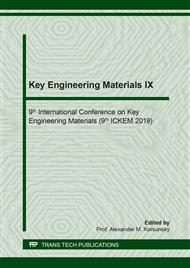[1]
K. M. Nampoothiri, N. R. Nair and R. P. John, An overview of the recent developments in polylactide (PLA) research, Bioresour. Technol. 101 (2010) 8493-8501.
DOI: 10.1016/j.biortech.2010.05.092
Google Scholar
[2]
Y. Yu, Y. Cheng, J. Ren, E. Cao, X. Fu and W. Guo, Plasticizing effect of poly(polyethylene glycol)s with different molecular weights in poly(lactic acid)/starch blends, J. Appl. Polym. Sci. (2015).
DOI: 10.1002/app.41808
Google Scholar
[3]
Y. M. Zhou, S. Y. Fu, L. M. Zheng and H. Y. Zhan, Effect of nanocellulose isolation techniques on the formation of reinforced poly (vinyl alcohol) nanocomposite films, Express Polym Lett 6 (2012) 794-804.
DOI: 10.3144/expresspolymlett.2012.85
Google Scholar
[4]
K. Leelachai, S. Ruksanak, T. Hongkeab, S. Kambutong, R.A. Pearson and P. Dittanet, Effect of cellulose functionalization on thermal and mechanical properties of epoxy resin, Key Eng. Mater. 757 (2017) 62-67.
DOI: 10.4028/www.scientific.net/kem.757.62
Google Scholar
[5]
W. Somphol, P. Prapainainar, P. Sae-Oui, S. Loykulnant and P. Dittanet, Extraction of Nanocellulose from Dried Rubber Tree Leaves by Acid Hydrolysis, Mater. Sci. Forum 936 (2018) 37-41.
DOI: 10.4028/www.scientific.net/msf.936.37
Google Scholar
[6]
W. Tappanawatch, P. Prapainainar, P. Sae-Oui, S. Loykulnant and P. Dittanet, Effect of Gamma Radiation on Properties of Cellulose Nanocrystal/Natural Rubber Nanocomposites, Key Eng. Mater. 772 (2018) 13-17.
DOI: 10.4028/www.scientific.net/kem.772.13
Google Scholar
[7]
D. Cheng, Y. Wen, L. Wang, X. An, X. Zhu and Y. Ni, Adsorption of polyethylene glycol (PEG) onto cellulose nano-crystals to improve its dispersity, Carbohydr. Polym. 123 (2015) 157-163.
DOI: 10.1016/j.carbpol.2015.01.035
Google Scholar
[8]
S. Qian, H. Zhang, W. Yao and K. Sheng, Effects of bamboo cellulose Nanowhisker content on the morphology, crystallization, mechanical, and thermal properties of PLA matrix biocomposites, Composites Part B 133 (2018) 203-209.
DOI: 10.1016/j.compositesb.2017.09.040
Google Scholar
[9]
M. M. Haafiz, A. Hassan, Z. Zakaria, I. M. Inuwa, M. S. Islam and M. Jawaid, Properties of polylactic acid composites reinforced with oil palm biomass microcrystalline cellulose, Carbohydr. Polym. 98 (2013) 139-145.
DOI: 10.1016/j.carbpol.2013.05.069
Google Scholar
[10]
L. Segal, J. J. Creely, A. E. Martin and C. M. Conrad, An Empirical Method for Estimating the Degree of Crystallinity of Native Cellulose Using the X-Ray Diffractometer, Text. Res. J. 29 (1959) 786-794.
DOI: 10.1177/004051755902901003
Google Scholar
[11]
Y. Zhou, T. Saito, L. Bergström and A. Isogai, Acid-Free Preparation of Cellulose Nanocrystals by TEMPO Oxidation and Subsequent Cavitation, Biomacromolecules. 19 (2018) 633-639.
DOI: 10.1021/acs.biomac.7b01730
Google Scholar
[12]
J. R. Capadona, K. Shanmuganathan, S. Trittschuh, S. Seidel, S. J. Rowan and C. Weder, Polymer Nanocomposites with Nanowhiskers Isolated from Microcrystalline Cellulose, Biomacromolecules. 10 (2009) 712-716.
DOI: 10.1021/bm8010903
Google Scholar
[13]
T. Saito and A. Isogai, TEMPO-Mediated Oxidation of Native Cellulose. The Effect of Oxidation Conditions on Chemical and Crystal Structures of the Water-Insoluble Fractions, Biomacromolecules. 5 (2004) 1983-1989.
DOI: 10.1021/bm0497769
Google Scholar
[14]
J. Hughes, R. Thomas, Y. Byun and S. Whiteside, Improved flexibility of thermally stable poly-lactic acid (PLA), Carbohydr. Polym. 88 (2012) 165-172.
DOI: 10.1016/j.carbpol.2011.11.078
Google Scholar
[15]
S. Qian and K. Sheng, PLA toughened by bamboo cellulose nanowhiskers: Role of silane compatibilization on the PLA bionanocomposite properties, Compos. Sci. Technol. 148 (2017) 59-69.
DOI: 10.1016/j.compscitech.2017.05.020
Google Scholar
[16]
W. Seangyen, P. Prapainainar, P. Sae-Oui, S. Loykulnant and P. Dittanet, Natural Rubber Reinforced with Silica Nanoparticles Extracted from Jasmine and Riceberry Rice Husk Ashes, Mater. Sci. Forum 936 (2018) 31-36.
DOI: 10.4028/www.scientific.net/msf.936.31
Google Scholar


